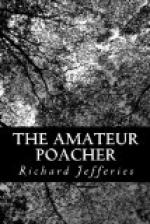The extreme severity of the frost naturally caused people to stay indoors, so that no one noticed the cart going through the village; nor could the track of its wheels be discerned from others on the snow of the highway beaten down firm. Even had the poachers been disturbed, it is doubtful if so small a staff of keepers could have done anything to stop them. As it was, they not only made a good haul—the largest made for years in that locality—but quite spoiled the shooting.
There are no white figures passing through the peaceful wood to-night and firing up into the trees. It is perfectly still. The broad moon moves slow, and the bright rays light up tree and bush, so that it is easy to see through, except where the brambles retain their leaves and are fringed with the dead ferns.
The poaching of the present day is carried on with a few appliances only. An old-fashioned poacher could employ a variety of ‘engines,’ but the modern has scarcely any choice. There was, for instance, a very effective mode of setting a wire with a springe or bow. A stout stick was thrust into the ground, and then bent over into an arch. When the wire was thrown it instantly released the springe, which sprang up and drew it fast round the neck of the hare or rabbit, whose fore feet were lifted from the earth. Sometimes a growing sapling was bent down for the bow if it chanced to stand conveniently near a run. The hare no sooner put her head into the noose than she was suspended and strangled.
I tried the springe several times for rabbits, and found it answer; but the poacher cannot use it because it is so conspicuous. The stick itself, rising above the grass, is visible at some distance, and when thrown it holds the hare or rabbit up for any one to see that passes by. With a wire set in the present manner the captured animal lies extended, and often rolls into a furrow and is further hidden.
The springe was probably last employed by the mole-catchers. Their wooden traps were in the shape of a small tunnel, with a wire in the middle which, when the mole passed through, set free a bent stick. This stick pulled the wire and hung the mole. Such mole-catchers’ bows or springes used to be seen in every meadow, but are now superseded by the iron trap.
Springes with horsehair nooses on the ground were also set for woodcocks and for wild ducks. It is said that a springe of somewhat similar construction was used for pheasants. Horsehair nooses are still applied for capturing woodpeckers and the owls that spend the day in hollow trees, being set round the hole by which they leave the tree. A more delicate horsehair noose is sometimes set for finches and small birds. I tried it for bullfinches, but did not succeed from lack of the dexterity required. The modes of using bird-lime were numerous, and many of them are in use for taking song-birds.




